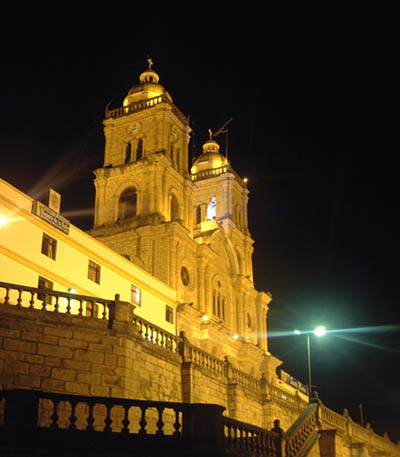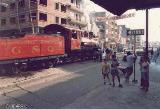Tourism in Azogues
Tourism in Azogues
ESC
Azogues has 32,000 inhabitants and is the capital of the province of Cañar, located in the south of it.
50 km from Azogues are the ruins of Ingapirca, one of the most visited sites in Ecuador.
Azogues and Cañar are famous for their crafts, especially for the manufacture of toquilla straw hats and their ceramic products.
Azogues
Among the multiple tourist manifestations of the Canton, the religious buildings and temples are located on an important historical level, and of national heritage, some of them built in yellow stone extracted from the old quarry, located on the Abuga hill, with designs of semicircular arches and with a Renaissance architectural style, which are currently admired by locals and strangers.
When you visit Azogues, do not hesitate to spend your time visiting the marvelous religious buildings in the City itself and its different parishes. In the attached document you will be able to appreciate some of these beautiful manifestations of faith, which make Azoguenos proud.
Other destinies, cities y sites
Quito - Guayaquil - Cuenca - Loja - Galapagos - San Cristobal - Ambato - Esmeraldas - Portoviejo - Guaranda
Vilcabamba - Mitad del Mundo - Ilinizas- Misahualli - Atacames - Baños - Otavalo - Chimborazo- Sangay
Iglesia La Catedral de Azogues
The Cathedral church is located in the central part of the city, between the streets: Matovelle, Bolívar, Serrano and Solano, the construction of this church began at the end of the 19th century, in this place the image of the Lord of Burgos is venerated, and It has a cemetery on the left side of the church.
The architectural characteristics of its construction consist of the front or main façade, the same one that is built in yellow stone extracted from the old quarry, located on the Abuga hill, its design is complemented by semicircular arches that give it the special characteristic for this type of buildings. The main altar of the church, is carved in fine wood, by workers of San Antonio de Ibarra. The internal part of the Church is made up of images, with different types of materials such as canvas, wood, marble, silver. There are images such as the Lord of Burgos, The Heart of Jesus, Immaculate Heart of Mary, Saint Francis of Assisi, The Lord of the Scourges, and the painting of Saint Joseph. a modern style, which preserves the line of construction.
Santuario Franciscano
The Franciscan Sanctuary is located in the eastern part of the Cañari Capital. Temple of unique and beautiful construction from the Republican period, all of it made of carved stone from the totemic Abuga hill, drawing attention to the symmetrical set of stairs, which from left to right add up to a total of 407 steps or steps to reach the temple. The High Altar of the Franciscan Sanctuary is entirely carved in fine wood by skilled workers from San Antonio de Ibarra, and the entire carved set is covered with gold leaf. In the central part of said Altar, there is the image of the Blessed Virgin of the Cloud, carved in wood by workers from the city of Azogues.
The great work begins on June 10, 1912, with the blessing of the first stone by Bishop Pólit.
The Feast of the Virgin of the Cloud is celebrated in the Sanctuary built in her honor, on the small hill of Calvary, on January 1 and May 31 of each year, the festival brings together thousands of pilgrims.
Iglesia del Señor de Flores
The church of Señor de las Flores, is located in the Bayas parish, on the slopes of Cerro Abuga, 1 km from the city of Azogues, it is one of the components of the religious Cultural Heritage of Azogues.
Iglesia de San Miguel de Porotos
The church of San Miguel de Porotos is located 9 km southeast of the city of Azogues.
Iglesia de Taday
The Taday church is located in the parish of the same name and is one of the oldest in Ecuador, it is around 457 years old.
Jatumpamba
The pottery town of Jatumpamba (from Quechua “jatum = large and pamba = flat, plain), is located 11 kilometers south east of the city of Azogues, in the parish of San Miguel de Porotos. Jatumpamba pottery is characterized by the elaboration of ceramic pieces, using the artisan technique of the "golpadores or huactanas" of conical clay. This technique was used by the Cañaris long before the Incas occupied these territories, evidence of them are the "beaters" found in archaeological contexts of Cañaris ceramics in the provinces of Cañar and Azuay.
Sombreros de paja toquilla
The manufacture of toquilla straw hats (Panama hats) is a craft activity that is very widespread in the province of Cañar; However, the weavers are concentrated around the communities of the Azogues canton, the carludovica palmata is the basic raw material for the production of hats commonly known as toquilla straw.
El Arte de Tallar en Piedra
The Rumiurco stonecutters are located in the Javier Loyola parish located 10 km from the city of Azogues.
The main material used for the elaboration of the sculptures is the gray stone or andesite that is extracted from the quarries of the Cojitambo hill.
Ingapirca
The ruins of ingapirca are at an archaeological level perhaps the most important in Ecuador.
It is an authentically Inca construction, made at the beginning of the 16th century AD, and could have been an observatory for the sun and the moon shortly before the arrival of the Spanish in that area. The set of archaeological vestiges of Ingapirca has been recorded by the outside world since at least the mid-18th century, although there are references to the place where these buildings are located -- Cañar Valley -- since the 16th century, when it was known as the province of Hatun Cañar (Quichua: Hatun Kañar), which means "the great place of the Cañar".
Complejo Arqueológico Cojitambo
Located 11 km west of the city of Azogues, in the parish of the same name. It is made up of an extensive complex of ruins that includes a Cañari-Inca trace with various stone structures that are distributed around a central plaza. On the north and west slopes there are numerous terraces superimposed in the manner of steps that ascend in semicircles to the edge of a cliff. These are residential terraces built by cutting into the slope and fillings supported by large retaining walls.
Due to the architectural characteristics and the existence of cultural materials that denounce a very old occupation of the site, we can infer that Cojitambo was inhabited during the Regional Development Period (500 BC- 500 AD), the Integration Period (500 - 1460 AD) In the Inca Period (1460 - 1532 AD) The archaeological site of Cojitambo is made up of an extensive complex of ruins, which rise on the plateau summit and the north and west flanks of the hill, adapting to the morphological characteristics of the terrain.
Fuentes: azogues.gob.ec, wikipedia







